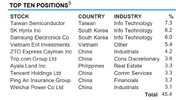Knobby22
Mmmmmm 2nd breakfast
- Joined
- 13 October 2004
- Posts
- 9,818
- Reactions
- 6,798
Profits up over 900%. Chips the main reason. Impressive company.

 www.bbc.com
www.bbc.com

Samsung: Tech giant sees profits jump by more than 900%
Chip prices recover from a post-pandemic slump while demand for AI-related products booms.

